An Archaeology of Silence: The Aniconic worlds of Mrinalini Mukherjee
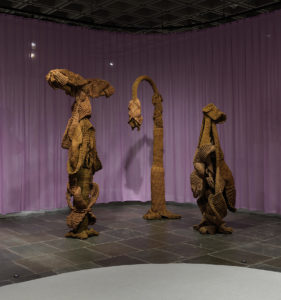
“Our job is to make the Anthropocene as short/thin as possible and to cultivate with each other in every way imaginable epochs to come that can replenish refuge”.
— Donna Haraway, “Anthropocene, Capitalocene, Plantationocene, Chthulucene: Making Kin”, Environmental Humanities
“But there is another reason why, from the writer’s point of view, it would serve no purpose to approach them in that way: because to treat them as magical or surreal would be to rob them of precisely the quality that makes them so urgently compelling—which is that they are actually happening on this earth, at this time”.
— Amitav Ghosh, The Great Derangement
The recently concluded retrospective on Mrinalini Mukherjee at the Met Breuer has revived dormant debates: Was Mukherjee isolated or cosmopolitan?; Is this elevation of craft to high art, tapestries to sculptures? Scholarship by Tania Guha, Victoria Lynn and Grant Watson has explored how such conceptual dichotomies are ill-suited to understanding Mukherjee’s labour, which reveals a deliberate dialectics of thought and form.
Given the retrospective and the accompanied attention to Mukherjee’s practice has coincided with the articulation of substantive civic concern with climate change—it is tempting to ask if the works present ways of thinking on urgent questions of ecology and the state of our planetary futures. This essay is concerned as much with the formal content of Mukherjee’s art as with the question of what it means to engage with these works amidst a growing public discourse on climate change.
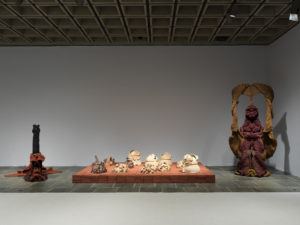
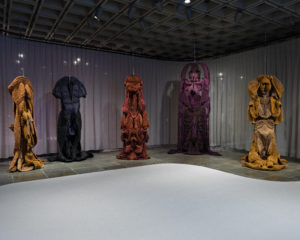
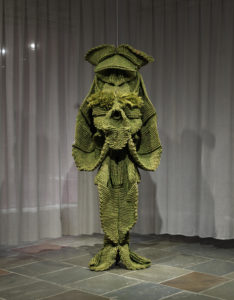
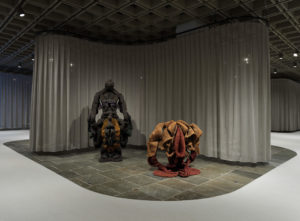
In the essay “Indian Roots for a Universal Idiom”Ahuja sieves through Mukherjee’s personal archive to present a photographic record of her visits across India and Southeast Asia, to temples and other sites of worship in ancient settlements, such as Hampi, Mahabalipuram, Ajanta and Ellora, Sitaranasal, Konark, Bhubaneswar. Mukherjee’s husband recorded the intricate facades of stone temples; figures of Nagas, Yakshis, Mithunas and Apsaras; and aniconic structures situated in the wild. The presence of foliage in these structures is regarded as intrinsic to the divinity of the site, and not viewed as encroachment or adornment. To Ahuja, the foliage and the structure are inextricable—the carvings and sculptures “emerge” from and are enframed by the vegetal expanse. He argues that through the rigorous documentation of the pastoral via photographic slides, and the production of three-dimensional sculptures that mimic the relief work on temple facades, Mukherjee is practicing “both an ethno-archaeology and a landscape archaeology in the contemporary”. This reading can be extended further to consider, does Mukherjee’s work and archive permit us to rethink the meaning of landscape itself?
Landscapes have traditionally been defined in a visual-representational plane, always accessed through the subjectivity of human presence. As much as landscapes have been viewed as mediated through the psyche, or in turn formative of human experience, in the study of art and photography it has been understood as inert—so much as the absence of human subjects is viewed as the reduction of pictorial function to a descriptive register that could be empty, or still. Landscapes exist as the domain of cultural and political practice, for W J T Mitchell, they are sites of power—and he has argued to shift the understanding of landscape from “a noun to a verb”.4 Mitchell states that the propagation of the contemplative gaze of the unencumbered subject of modernity has worked to conceal the imperial and industrial influence on the natural imagination from the early nineteenth century, where expeditions and excursions became symbols of annexation. As Karen Barad notes, our understanding of landscape as context for human activity has fundamentally shaped disciplinary tenets. She argues that “matter” is not, in fact, “little bits of nature, or a blank slate, surface, or site passively awaiting signification, nor is it an uncontested ground for scientific, feminist, or Marxist theories. Matter is not immutable or passive. Nor is it a fixed support, location, referent, or source of sustainability for discourse”.5 To view the matter as active beyond the human, driven as much by the biotic as the abiotic, is to think of the scalar impact of the Anthropocene, a period of intense human activity in the form of industrial and post-industrial processes, has propelled the extinction of landscapes, species and processes that may be difficult to revive.
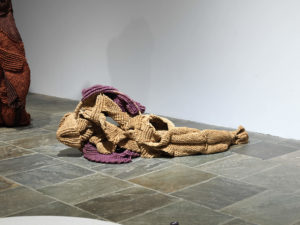
Notes
- Jhaveri notes how Mukherjee’s selection of the ubiquitous material such as natural ropes, was a highly unusual gesture, appended by her refusal of traditional looms in favour of provisional frames and armatures. Mrinalini Mukherjee, eds. Shanay Jhaveri and Grant Watson (Shoestring Publishers, 2019).
- Naman Ahuja, “Indian Roots for a Universal Idiom, ” in Mrinalini Mukherjee, eds. Shanay Jhaveri and Grant Watson (Shoestring Publishers, 2019).
- Judith Butler, Bodies That Matter: On the Discursive Limits of “Sex” (New York: Routledge, 2013), 2.
- W J T Mitchell, Landscape and Power (Chicago: University of Chicago Press, 1992), 1.
- Karen Barad, Meeting the Universe Halfway: Quantum Physics and the Entanglement of Matter and Meaning (Durham and London: Duke University Press, 2007), 151.
- David Farrier and Aeon, “The Concept of Deep Time is Changing,” The Atlantic, October 31, 2016, URL: Click Here

